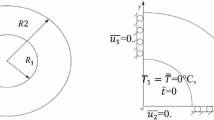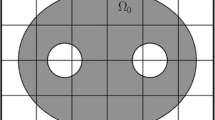Abstract
The boundary element method (BEM) is now a versatile and powerful tool of computational mechanics which has become a popular alternative to the well-established finite element method (FEM). Recently, some authors indicated that the presence of any domain integrals undermines most advantages of the BEM. We believe that this is not true if the domain integral contains known quantities (such as body sources or initial values). The actual sources of advantages of the BEM formulation are not determined by the question of if it is necessary to discretize the domain or not. The BEM formulation for the solution of a boundary value problem exhibits pure boundary character if the solution at any internal point can be expressed in terms of the boundary integrals of relevant quantities and the domain integrals of known body sources and initial values, if any. In other words, the solution can be expressed at an internal point without the need to know the solution at any other internal point. If the boundary values of the relevant quantities were known exactly and the integrations were performed with absolute accuracy, the integral representation would present the exact solution of the boundary value problem. That is why in the BEM solution, extreme emphasis is put on the accuracy of the approximations of boundary values and computation of boundary integrals. Since in the domain discretization techniques (such as FEM, finite difference method, collocation methods) the unknowns at all nodal points are computed simultaneously, the computational error is accumulated.
Access this chapter
Tax calculation will be finalised at checkout
Purchases are for personal use only
Preview
Unable to display preview. Download preview PDF.
Similar content being viewed by others
References
Nowacki, W. Dynamic Problems of Thermoelasticity, PWN, Warsaw, 1975.
Balas, J., Sladek, J. and Sladek, V. Stress Analysis by Boundary Element Methods, Elsevier-Veda, Bratislava, 1989.
Sladek, V., Sladek, J. and Balas, J. Boundary Integral Formulation of Crack Problems, ZAMM, Vol. 66, pp. 83–94, 1985.
Sladek, V. and Sladek, J. Boundary Integral Equation Method in Thermoelasticity Part I: General Analysis, Appl. Math. Modelling, Vol.7, pp. 241–253, 1983.
Sladek, J. and Sladek, V. Boundary Integral Equation Method in Thermoelasticity Part II: Crack Analysis, Appl. Math. Modelling, Vol.8, pp. 27–36, 1984.
Sladek, V. and Sladek, J. Boundary Integral Equation Method in Thermoelasticity Part III: Uncoupled Thermoelasticity, Appl. Math. Modelling, Vol.8, pp. 413–418, 1984.
Sladek, V. and Sladek, J. Boundary Integral Equation Method in Two Dimensional Thermoelasticity, Engn. Analysis, Vol.1, pp.135–148, 1984.
Sladek, V. and Sladek, J. Three Dimensional Crack Analysis for Anisotropic Body, Appl. Math. Modelling, Vol.6, pp. 374–380, 1982.
Brebbia, C.A., Telles, J.C.F. and Wrobel, L.C. Boundary Element Techniques. Theory and Applications in Engineering, Springer-Verlag, Berlin, 1984.
Narayanan, G.V. and Beskos, D.E. Numerical Operational Methods for Time-Dependent Linear Problems, Int. J. Num. Meth. Engn., Vol.18, pp. 1829–1854, 1982.
Durbin, F. Numerical Inversion of Laplace Transforms: An Efficient Improvement to Dubner and Abate’s Method, Comput. J., Vol.17, pp. 371–376, 1974.
Boley, B.A. and Weiner, J.J. Theory of Thermal Stresses, Wiley and Sons, New York, 1960.
Sih, G.C. and Liebowitz, H. Mathematical Theories of Brittle Fracture. Chapter 2, Fracture, An Advanced Treatise, (Ed. Liebowitz, H.), Vol.2, pp. 67–190, Academic Press, New York, 1968.
Sladek, V. and Sladek, J. Computation of the Stress Intensity Factor in 2-d Stationary Thermoelasticity, Acta Technica CSAV, Vol.32, pp. 217–229, 1987.
Sladek, J. and Sladek, V. Improved Computation of Thermal Stresses in Stationary Thermoelasticity Using Boundary Elaments, ZAMM, Vol.70, pp. 141–147, 1989.
Sladek, J. and Sladek, V. Transient Thermoelastic Crack Problems in Three Dimensions, Staveb. Cas., Vol.35, pp. 337–348, 1987.
Gradshteyn, I.S. and Ryzhik, I.M. Table of Integrals, Series and Products, Academic Press, New York, 1965.
Sladek, V. and Sladek, J. Nonsingular BIE for Transient Heat Conduction, Engn. Analysis (to appear)
Sladek, V. and Sladek, J. Computation of Thermal Stresses in Quasi-Static NonStationary Thermoelasticity Using Boundary Elements, Int. J. Num. Meth. Engn., Vol.28, pp. 1131–1144, 1989.
Sladek, V. and Sladek, J. Improved Computation of Stresses Using the Boundary Element Method, Appl. Math. Modelling, Vol.10, pp. 249–255, 1986.
Sladek, J. and Sladek, V. Computation of Stresses by BEM in 2 — d Elastostatics, Acta Technica CSAV, Vol.31, pp. 523–531, 1986.
Markeehova, I., Sladek, J. and Sladek, V. Computation of Stresses in Nonhomogeneous Bodies Using BEM, Acta Technica CSAV, Vol.34, pp. 487–511, 1989.
Ghosh, S. and Mukherjee, S. Boundary Element Method Analysis of Thermoelastic Deformation in Nonhomogeneous Media, Int. J. Solids Structures, Vol.20, pp. 829–843, 1984.
Tanaka, K. and Tanaka, M. A Boundary Element Formulation for Coupled Thermoelastic Problems I. Governing Integral Equations, Rev. Roum. Sci. Techn.Mec. Appl., Vol.26, pp. 83–94, 1981.
Tanaka, M. and Tanaka, K. A Boundary Element Formulation for Coupled Thermoelastic Problems II. Boundary Element Discretisation, Rev. Roum. Sci. Techn.-Mec. Appl., Vol.26, pp. 257–263, 1981.
Tanaka, M., Togoh, H. and Kikuta, M. Boundary Element Method Applied to 2 — D Thermoelastic Problems in Steady and Non-Steady States, Engn. Analysis, Vol.1, pp. 13–19, 1984.
Rizzo, F.J. and Shippy, D.J. An Advanced Boundary Integral Equation Method for Three-Dimensional Thermoelasticity, Int. J. Num. Meth. Engn., Vol.11, pp. 1753–1768, 1977.
Masinda, J. Application of the Boundary Element Method to 3 — D Problems of Non-Stationary Thermoelasticity, Engn. Analysis, Vol.1, pp. 66–69, 1984.
Sharp, S. and Crouch, S.L. Boundary Integral Methods for Thermoelasticity Problems,J. Appl. Mech., Vol.53, pp.298–302, 1986. 30. Sharp,S. and Crouch,S.L. Heat Conduetion, Thermoelasticity and Consolidation. Chapter 10, Boundary Element Methods in Mechanies, (Ed. Beskos, D.E.), Vol.3, Elsevier Science Publ., Amsterdam, 1987.
Koizumi, T. et al. Boundary Integral Equation Analysis for Steady Thermoelastic Problems Using Thermoelastic Potential, Jour. Thermal Stresses, Vol.11, pp. 341–352, 1988.
Ochiai, Y. and Sekiya, T. Unsteady Thermal Stress Analysis in Compound Region by Means of Thermoelastic Displacement Potential and Boundary Element Method, Jour. Thermal Stresses, Vol.12, pp. 57–65, 1989.
Henry, D.P. and Banerjee, P.K. A New Boundary Element Formulation for Two-and Three-Dimensional Thermoelasticity Using Particular Integrals, Int. J. Num. Meth. Engn., Vol.26, pp. 2061–2077, 1988.
Chaudouet, A. Three-Dimensional Transient Thermoelastic Analysis by the BIE Method, Int. J. Num. Meth. Engn., Vol.24, pp. 25–45, 1987.
Smith, D.W. and Booker, J.R. Boundary Integral Analysis of Transient Thermoelasticity, Int. J. Num. Anal. Meth. Geomech., Vol.13, pp. 283–302, 1989.
Rizzo, F.J. and Shippy, D.J. A Method of Solution for Certain Problems of Transient Heat Conduction, AIAA, Vol.8, pp. 2004–2009, 1970.
Tanaka, M., Togoh, H. and Kikuta, M. A Boundary Element Investigation of 3 — d Thermoelastic Problems in Transient Heat Conduction States, in Boundary Elements VII (Ed. Brebbia, C.A. and Maier, G.), pp. 3.3–3.18, Proceedings of the 7th Int. Conf. on BEM, Lake Corno, Italy, 1985. Springer-Verlag, Berlin, 1985.
Dargush, G.F. and Banerjee, P.K. Development of a Boundary Element Method for Time-Dependent Planar Thermoelasticity, Int. J. Solids Structures, Vol.25, pp. 999–1021, 1989.
Sladek, V. and Sladek, J. A New Approach to Transient Dynamic Analysis of Thermoelasticity by the Boundary Element Method, Engn. Analysis, Vol.2. pp. 221–229, 1985.
Author information
Authors and Affiliations
Editor information
Editors and Affiliations
Rights and permissions
Copyright information
© 1992 Computational Mechanics Publications
About this chapter
Cite this chapter
Sladek, V., Sladek, J. (1992). Advanced Thermoelastic Analysis. In: Wrobel, L.C., Brebbia, C.A. (eds) Boundary Element Methods in Heat Transfer. Springer, Dordrecht. https://doi.org/10.1007/978-94-011-2902-2_7
Download citation
DOI: https://doi.org/10.1007/978-94-011-2902-2_7
Publisher Name: Springer, Dordrecht
Print ISBN: 978-1-85166-726-0
Online ISBN: 978-94-011-2902-2
eBook Packages: Springer Book Archive




